The next reality of financial services
With its immersive experiences and growth opportunities, VR has become an empowering tool and a controversial topic,
As industries navigate into an intelligent era, let us look at how can we integrate and take advantage of these virtual frameworks.
I. Innovation is a process, not an idea.
In the history of economic evolution, an invention is of no economic significance until it is brought into use. An iPod would have been a curiosity if Apple have not innovated the business models of the music industry and entertainment. Entrepreneurs and business leaders are responsible for translating inventions into innovation, leveraging market & technology. Looking at the timeline of market innovation, we can appreciate that globalization didn’t happen seemingly overnight: desktop computers in the ’90s, the web in 2000, mobile tech in 2010. Around that time, my business partner Ariel and I were showcasing AR products using Unity made with QR’s on the new iPad in local marketing expos. We were on the right path, but ahead of our time. For many, VR is just a trend, but looking past the sci-fi flashy interfaces portrayed in movies, the Metaverse is here to stay. The speed, scale, and impact of machine learning and virtual frameworks in our lives are beyond measure.
With the pandemic as a catalyst, remote work took place, we skipped stores, supermarkets, restaurants and movie theaters, favoring delivery, streaming & online shopping. Later, basically, every meeting, conference, school, and church services moved virtually. Even my mom with 78 yo. understand the meaning of ‘avatar’ and ‘memoji’. From entertainment to retail, fashion shows, fandom events, company town halls, training sessions, shareholder meetings, and political referendums. VR moved past gaming to education, sports, health, finance, and politics. Yes, I said politics.
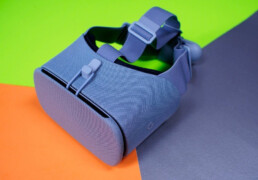

II.Machine Learning is not just for games & furniture mapping.
Simply explained, machine learning is the ability for a system to learn and improve from experience, without being explicitly programmed -and is one of the subset technologies that make up “Artificial Intelligence”.
The reason that machine learning has exploded in the last years is due to major improvements in GPU processing speed and the monumental amount of data that is available for machine learning and deep learning algorithms to feed on.
Machine learning, therefore, is redefining the way FinTech products are conceived and built, and companies are turning to AI-driven applications and VR/AR to help them make complex decisions and map and visualize unimaginable amounts of data. In 2018, the VR market was worth about US$7.9bn. In only 2 years from today, that figure will amp to $44.7bn. As for the financial services sector, the numbers are even bigger: 26,5 trillion dollars -larger than the US GDP, and twice as large as the Chinese economy- but these numbers don’t reflect the levels of efficiency and user engagement. The many inefficiencies in this sector make big banks, insurance companies, and private equity firms lose billions of dollars every year due to technology weak points and bureaucratic loopholes.
Fintech startups snatch the opportunity and armed with ambition, exploration and a user-centered approach were able to improve, revive and redefine ancient narratives and carve a place in a stale industry. Alipay eliminated cash transactions in China from Shanghai to Sichuan, just armed with a phone and a QR. And Stripe product simplicity is now become one of the largest payment processors in the US, gearing up for a major international expansion, even the native ATL startup Kabbage introduced an AI-based lending platform.
VR is not only for gaming or mapping furniture inside buildings, but can also see the internal organs of critical patients where seconds are a matter of life. ML and AI-based applications are the key to better decisions, smarter experiences, and successful outcomes.


III. Embrace Lab Culture, Exploration & Creative Research
Technological foundations are still evolving, no agreed standards across the multiple meta-verses have been set. Companies might be reluctant to invest in infrastructure, tools, and talent. As the path for virtual framework unfolds and VR tech is becoming mass-produced, we have to be ready. Artificial intelligence will drive massive value creation, and Users are demanding operational efficiency and cutting-edge technologies that can implement real-time features and solutions. Institutions and companies need to embrace Lab Culture, exploration & creative research. It’s key to collaborate with outside partners that can offer new perspectives and values, and integrate them across journeys, platforms, and experiences. Supporting developers and artists is also essential, so they can create state-of-the-art tools and interfaces to empower the ecosystem.
Most of the required technologies to create this ecosystem exist, and some are still work-in-progress. But this virtual place named ‘metaverse’ is already alive. Companies are still far from developing their own meta-verses, but heavily investing and partnering through experimentation, creativity, and understanding. Just like any other technology, discovery, or market, services will evolve to build out the content, the market, and the availability. The industry is catching, but some institutions struggle to deliver engaging banking solutions and omnichannel brand communication -more often focusing on the product and not the users- But consider VR framework as an opportunity to get ahead of the competition, increase efficiency in certain operations and enhancing the overall user experience.
The virtual marketplace is an organic extension for financial technology, the time and cost savings, plus benefits, are ideal for users and institutions. Users can enjoy premium service with AI assistance, discover ways to improve portfolio, take advantage of customized financial opportunities, and have real-time access to all the services the traditional bank can offer. And we haven’t talked about NFTs and blockchain-based currencies -two major components of the metaverse revolution. ReedPOP recently unveiled “Metaverse Memberships” programs that offer benefits in both physical and digital throughout their Comic-Con events. I worked with Airline loyalty programs in the past, and this could be the next evolution in a billion-dollar industry.


The virtual framework will drive economic opportunities. For companies, to make accurate and faster decisions, supporting business and partners throughout their digital transformation journey. For users, the same, enabling better experiences and shaping unique narratives and relationships. A place filled with all the opportunities you can imagine, with a single interface that adapts to each user in real-time, regardless of the hardware, language, and location, creating their own path and focusing on discovery. A truly immersive user-centered experience. For us, it’s time to be creative, collaborative & strategic, inspiring clients, and audiences to create value and manifest the change that matters.
Unleash your DX development team experience
The Developer Experience (DX) covers a wide range of human factors, perceptions, and elements that impact productivity, quality, and reliability of your product. How can we make it better?
In many teams, DX (developers’ experience) is often an afterthought. There are a lot of resources and emphasis on User Experience (UX) but developers are users, and actually are the first that use your product, frameworks, and tools. As customer satisfaction and happiness are crucial for the success of your product, the same goes for the people involved in the process to create that project. Positive mindset or ‘happy’ developers create exceptional software in the long term. A positive developer experience ensures that your developers are happy, satisfied, and less likely to leave your team. It’s not just a framework but a focus on the importance of autonomy, culture, network, and experiences, both individual, tribal and company-wide.
The factors range from emotional to technical, small details and dynamics that make it or break it, like a line of code. Motivation, environment, tools, and challenges all come into play when it comes to a good DX. how we can improve it and make it wonderful?

We focus on three main areas:
Infrastructure (development, management tools, programming languages, libraries, platforms, and methods) Emotional perception (trust, respect, solidarity, belonging), and Value (personal and project goals, aspirations, contributions, success, and commitment).
1. Infrastructure

Find a compromise between simple and more complex architecture. Simple means more pain later, complex brings more pain now. Consider the size of your project and your team. Good architecture is difficult to break, has short feedback loops and allows better analysis.
Automation is also the key to high-performance teams, like giving superpowers. The proper tools will help your team to
Deliver value to production fast, anticipate and fix bugs, optimize and build high-quality codebases. It gives teams freedom, skipping allowing more confidence. Also, well-defined processes reduce anxiety, give you discipline and consistent steps that fuels creativity, clarity, and flow. From QA, deployment, feedback, and even a particular project onboarding.
2. Emotional synergy
Trust, friendliness, and honesty, emphasize sincerity with respect in every detail. Great sense of ownership, responsibility, and success, both personally and within the company.A unified goal creates also a mature and healthy environment, from inside the team, division, and the company as a whole.
Also, this synergy allows for failure and inspires courage. Risks should always be calculated, and developers have to be aware of how interconnected their actions are. It is crucial to be able to take responsibility. Again, team discipline relieves anxiety, tension and creates space for experimentation. Even when you are busy, small moments of relax can renew individual and team creative energy flow.
As leaders, empathizing with your users, stakeholders, and team means understanding their needs within the project. It also plays a major role when working cross-functionally. A wider background experience enables team leaders to intuit the needs of the internal users involved, improving DX in an epic manner and facilitating communication, feedback with other key stakeholders, and high engagement within their specific roles. A people-driven, autonomous approach for scaling agile by focusing on communication, accountability, and quality will deliver innovation and productivity to teams and organizations.

3. Value & Purpouse
The purpose is very important, in your company, but also in each individual and team. Making money should not be the only goal. A company’s culture itself is the most important brainware. A sense of impact, understanding that their work matters and they are inspiring the world through improving someone else’s life. When I started in Wunderman, one of my focuses was to reverse the high rate of talent churn in development to design teams. Just understanding the impact, reach and influence of the work everyone did, created a sense of ownership, professionalism that impacted productivity, quality, and reliability of the product but also lead the team evolution to a high-performance autonomous unit. Considering your team’s emotional cost is key to your product success.

Although this brief insight covers concepts and knowledge I use daily on personal and professional projects to ship products or experiences, Im aware that it takes time and effort also from the day-to-day workflow, and will transform positively and happily your development outcomes. Trust me, small changes can deliver huge impact and difference in your team workflow. The next article will cover more technical tips to improve DX. I’d love to see how this could impact your team experience. Hit me up on Twitter and let me know how can we inspire more of this. Be tuned for next updates and thanks for reading!
Creating a team identity.
How do we inspire and support our teams to deliver their best performance, creativity, and unique point of view into the game? 5 simple approaches to leverage your global team into a collaborative, focused, and engaging global workforce.
Global teams located in different geographies are often viewed more as a challenge than an advantage. The key factor is to draw from its diversity and abilities to bring different cultural experiences to improve, built, and expand not only projects but also the unique company culture. The growth and evolution of a project balance individual contributions and collective engagement and streamlined vision.The challenge is not in the level of social distance, but in the degree of emotional connection among team members. Fostering positive relational dynamics, interactive communications, and team building strategies to mentor individuals and teams, to overcome and negotiate tensions across timezones, countries, and cultures.
Misunderstandings within the global teams can either produce costly consequences or remarkable innovations, creating millions of dollars in value for their customers and shareholders.
Creating a team identity beyond language.
Audiences and markets have become globalized and teams have grown to an amazing ecosystem of culturally diverse talents, inspiring brands across the globe with unlimited growth opportunity and fresh perspectives. We have offshore teams with copywriters and designers in London, development & QC in Buenos Aires, software engineers in Chennai and marketing teams in NYC. Maybe your campus in Prague has members from different nationalities.
Inspiring and managing teams is a wonderful challenge, and with team members from different countries and different cultural backgrounds and languages, it requires also a fresh and diverse perspective as their teams itself. Wherever your team is in one office or globally dispersed, they are expected to deliver their best performance, creativity, and unique point of view into the game. So, how do we leverage, support and inspire such a diverse workforce?
Language and cultural differences.
One of the key components of every collaborative relationship is trust, and open communication among team members is key. Language proficiency is a challenge and can undermine trust between its members. Colleagues with different levels of proficiency could be perceived as less communicative or reliable, undermining healthy trust-building in each other’s abilities and skills. It is crucial to find ways to transform these differences, into creative energy. It’s important to explore those differences so we know how to interact and grow as a group.
A way to encourage this understanding of diversity is to create unstructured moments, not necessarily ‘a meeting’- where everyone can share their cultural background and expectations about communication and working style. The team gets to learn more about each other by listening, sharing and asking questions and sharing about their backgrounds, even to learn what kind of food they like, or learn a traditional recipe from your home. It’s amazing when teams discover that we are not that different after all.
Teams experience a lot of pressure, and members of multi-language teams frequently relieve stress by switching into their native tongue, inadvertently excluding other teammates from their conversations. We need to reverse language barriers and communication anxiety by encouraging open dialogue in teams as a whole, creating a “team identity” equipped with amazing different strengths and unique backgrounds, united in one vision. Like a team of superheroes.
Reducing language gap
The success and strength of every multi-national team reside in one basic -but rather complex- aspect: communication. How can you measure the degree of language connection among team members? When people come from similar nationalities, the level of ‘language distance’ is usually low. Even if they come from different backgrounds, people can interact formally and informally, align, and build trust. They arrive at a common understanding of what certain behaviors mean, and they feel close and congenial, which fosters good teamwork.
Coworkers who are geographically separated, or come from different countries and cultures, could experience some kind of language anxiety that could prevent interactions. This originates from the inability to communicate, missing information and/or negative evaluation. This negative dynamics reduce team performance, and especially for creatives, artist, and designers, where creative energy, collaborative expression, and multi-team interaction is vital.
Creating a team identity
In a team, is important that everyone gets enough speaking time, and that everyone knows what they’re working toward. What’s our vision and why we are doing what we do. Bringing everyone around common goals and a unified vision is key. I can not stress this more! as evident it may seem, this is poorly done, and team members spot it quickly when is fake. Is has to be an honest take, not a speech. That’s why you need to know the brand, the clients, the team, the story. You need to be the first one to believe it to be able to inspire it. Highlighting the importance of each diverse skill in your team will level up the group dynamics, and also how much value the team is contributing to the success of the service, product or brand. Be open about the unique appreciation for everyone’s input and encourage meta-communication. Each particular story amounts to create a more solid, trustworthy and collaborative team.
Bringing everyone around a unified vision is key. Its has to be an honest take, not a speech. That’s why you need to know the brand, the clients, the team, the story. You need to be the first one to believe it to be able to inspire it.
Break down your common goal into actionable steps and outline each individual’s role and responsibilities. This reduces the chance of misunderstandings and lets everyone know that their contribution matters. Clarity of each team member’s contribution also makes it easier to address team performance as a whole. It sets expectations for what needs to be done, by who and when.
Building a team identity also entails finding common things between team members. Make space in your working day to promote team interactions, to get to appreciate each other team members. Perhaps there are teammates who share the same taste in movies, music or TV shows. Some may bond over hobbies or share information about their families, etc. Personal connections within the team make it easier to work together, trust and have a solid team identity.

To be continued…
Analytics to Predict Blockbusters
Analytics helps us to connect pieces of research, identifying the right elements to create a unique experience. “Jurassic World” movie is the perfect case study on how research, facts and behaviors can support a multibillion dollar franchise.
Not Another Sequel
We all went ”ugh… please-not-another-sequel!” when we heard the rumor of a Jurassic Park sequel. Apparently, we were wrong. Against all odds and rumors, the dino-action sequel literally ate box office records, with a staggering 208.8 million domestically this weekend, making it the highest grossing opening weekend film of all time.
As of today, Mr. T-Rex is the richest dinusaur in the world. 1.672 billion USD box office worldwide. Raawrr!! Grossing a total of $652,270,625 in USA and $1,019,442,583 internationally. Roughly $600 millions are from Asian markets, China and South Korea leading in Asia; UK, France, and Germany in Europe and finally Mexico and Brazil in Latin America respectively.
The industry is changing the way they do business and technology is doing its part. Analytics tools had proven to be successful, making connections between pieces of research, identifying facts and behaviors. Jurassic World is relevant example of this The audience ‘body language’ was pretty clear: On that weekend, the re-post rate for Jurassic videos on YouTube was 45 to 1 (the average is 9 to 1). The trailer on the official Universal channel got 66.6m views (multi-channel networks money well invested) Twitter almost broke: #JurassicWorld peaked at 63K. The “conversation” for the film was very high and very positive on social media that weekend. Thousands and millions share trailers with their community, on multiple social channels. And that’s intent of purchase…like a kiss. Plus, no big sports events or soccer matches on TV that weekend. Add shirtless Chris Pratt and school calendars and TV were packed with dino-theme curricula. Finally, people just love seeing Pterosaurs munching on tourists! Go family-friendly entertainment! Jurassic World broke box office, scoring the biggest opening weekend in history with a sweet $511.8 million in tickets sales worldwide, outdoing even Harry Potter.
Timing is everything
“Jurassic World” was shrewdly positioned as the June blockbuster to beat, ceding April to “Furious 7” and steering clear of “Avengers: Age of Ultron’s” May release. After “Tomorrowland” flopped over Memorial Day, there was some gum-flapping among box office analysts about whether Universal erred in not putting “Jurassic World” over the four-day holiday. In retrospect, it was the perfect move. The box office, which was coming off of three consecutive lackluster weekends, needed to cool down before it could heat up again.
“You could see this coming after a number of films that didn’t live up to expectations,” said Jeff Bock, a box office analyst with Exhibitor Relations. “There was just this hunger for a big summer tentpole film.”
The studio benefited from timing of another sort. Over the past decade and a half, the fourth “Jurassic Park” saw various filmmakers and screenwriters, such as “The Departed’s” William Monahan and “I Robot’s” Alex Proyas, come on board before getting tossed aside after failing to find the right creative direction for the film. The tortured development worked in “Jurassic World’s” favor, giving it distance from “Jurassic World III,” which is generally considered to be the series’ nadir, and lending the franchise a feeling of freshness.
Premium formats are prime
The Indominus rex, basically a T-rex on steroids, demanded to be seen on the biggest, widest, most souped-up screens possible. That meant that “Jurassic World” got a major boost from premium large format and Imax screens, along with 3D showings. The sequel took in 48% of its domestic opening weekend receipts from 3D screens while setting new high-water marks for Imax and private label PLF screens.
Those formats were in their infancy when “Jurassic Park III” was in theaters — 3D was still a novelty and Imax was reserved for nature films.
“I use my kids as a bit of a barometer,” said Anthony Marcoly, president of worldwide cinema for 3D-maker RealD. “They’ve seen the ‘Jurassic Park’ movies before, but they’ve seen them on TV or DVD. They haven’t had a chance to see a ‘Jurassic’ movie on these big [premium large format] screens or in 3D. People wanted to be brought into the world of ‘Jurassic’ and to see it in a grand fashion and just be drawn into the story.”
It also helped that Trevorrow talked up the virtues of seeing “Jurassic World” with all the extra bells and whistles on promotional videos and by appearing before screenings at the Imax TCL Theater in Los Angeles.
“This is a shared experience,” he told the crowd at one of these events. “It’s why we go to the movies.”
The exhibition industry has taken its knocks for not keeping up with the digital revolution that has upended the entertainment landscape, but “Jurassic World’s” success with tinted specs and sprawling screens demonstrates the lengths that theaters have gone to differentiate their experience from the one found in the living room or at the keyboard. Times have changed, of course, but some of it’s for the better.
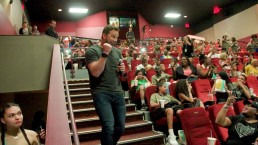
Dinosaurs ripping apart humans = appropriate for children of all ages
It’s been 26 years since “Jurassic Park” first illustrated the dangers of bringing velociraptors back to life, and in that time one generation of film fans has come of age and another has emerged. That means that a group of moviegoers who were first weaned on popcorn pics with that first film have grown up and were eager to introduce their sons and daughters to the magic of a T-rex rampage.
To familiarize a new group to the pleasures of the park, Universal reissued “Jurassic Park” in 3D in 2013 in conjunction with its 20th anniversary. It also primed the pump in a nice piece of corporate synergy, hosting a special presentation of “Jurassic Park” last week on NBCUniversal Networks that included interviews with Pratt and Spielberg. The film and TV stations share a corporate parent in Comcast.
The PG-13 rating made the prospect of seeing pterosaurs treat tourists like birdseed something of a family event. That resulted in an opening weekend crowd that was 39% under the age of 25, a demographic that hadn’t been born or was barely verbal when the first film debuted.
“We’re getting everybody and that includes parents with kids,” said Carpou.
Hollywood take note. That’s how you build a blockbuster.
Making Sense of fragmented audiences
Audiences consume and interact with information in unexpected ways, so you have to be tuned in real-time. Consider what’s going on in the analytics and reports, and out of them. Data is generated and delivered by the same audience you are trying to connect, from video channels, chat, social media and tweets. Paying attention to the ‘vibe’ or body language cues can go a long way. Use them to your advantage. Analytics can be tricky, but they are just the tip of the data iceberg. Keep your cool, be yourself and be responsive. Pick your actions accordingly and maybe it could be the start of an unforgettable relationship.
Yesterday afternoon, Marvel Studios showed some chivalry by releasing a poster (a tweet by president Kevin Feige) congratulating Steven Spielberg and the Universal Studios team, Director Colin Trevorrow and golden boy Chris Pratt for beating the hero team, since their lost their title as the previous record holder. With these numbers, we will be seeing more Jurassic (probably without ‘The Park’) in the future.
Transforming kids content playground
The game-changer: deliver knowledge
From Tiktok to YouTube, younger generations are influenced by a diet of digital content at a very early age. Media companies are focusing to understand what kind of content is more attractive to this ‘Generation Z’. Getting an accurate track is challenging since the majority of content is consumed on smartphones, tablets, and game console devices that still are not included in the ratings. Besides guessing what content is ‘popular’ or successful, there’s also ad revenue decline. The question is how this will reflect on subscribers, new users, and customers in the long run.
Delivering innovation, and not as a buzzword, is more than tech, apps, or new marketing: is a mindset, on how we approach business and content. As a creative and designer, successful business is how can brands relate with audiences, but going a step forward in how we deliver knowledge. This is the real game-changer.
Educational content, the key to the future
Operators generally target families, becoming key drivers of on-demand offerings. Netflix is one of the largest providers of online children’s content through output agreements, but they produced (or acquired) their own content since Disney+ launched its powerhouse streaming, the same with HBOMax feeding from Cartoon Network lineup. Amazon and Discovery, same story. How can we keep up -and more important- be at the top of the game? One approach is to create a market, understand the market, and leverage products and services to its needs. More than revolutionary, it’s smart. The Danish family-owned business LEGO is a fantastic business example, from associating movie franchises and IP’s with its pint-sized heroes, games, movies, etc, to launching major educational programs and learning products in China, the US, and Europe. We need a LEGO Channel asap.
Inspiring children through creative play and learning
It’s not just about having fun, but also delivering purposeful, problem-solving narrative entertainment. Educators, artists, science experts, and creators need to assemble and inspire the next generation, now. This is one of the main drivers growing both business and quality for kids’ content and media.
A decade ago, The Jim Henson Company created Sid the Science Kid (2008), dedicated to teaching science to preschoolers. PBS and other networks saw the genius in the idea. Today, STEAM programs are a must in every serious school program, even popular programming for kids from three to thirteen relate to this. Fun and great STEAM programming have created a diverse and exciting universe of content to stimulate young imaginations and make all kids feel like they can play at being an inventor, engineer, scientist, or artist.
LEGO® Education SPIKE™ Prime student classes enable kids to develop stronger critical thinking and problem-solving skills
Educational entertainment: a bright future
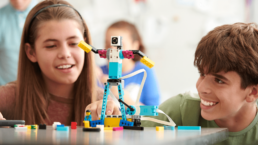
Companies are in creating a new slate of children’s and YA content. Roku, Apple TV, Android TV, and Chromecast join the ranks of Netflix (MC2/Magic School Bus), Amazon (Annedroids/Creative Galaxy/Tumble Leaf), PBS (Sci Girls/Sid the Science Kid/DinoTrain), and Marvel TV with kids’ specific educational content aimed to engage fans building audience strategies for years to come. From integrated educational programs and award-winning content, companies created a whole series of solutions for younger students and help teachers to leverage and engage with their students. We need educational evolution to avoid mental extinction.
Streaming content like “Doozers” (Hulu), focus on “design teaching” based on engineering and design, fantastic machines using recycled resources. Playing creates a perfect opportunity for kids (and adults) to become active, collaborative learners and have fun. Annedroids (Amazon) Its also very much connected to STEAM curricula. Kid-scientist Anne has invented and built her own amazing androids in her backyard lab and enlisted the help of other kids in the neighborhood.
Xbox, more than games
Even Xbox users already spend more time watching video than playing games with the device and heavyweights like Nickelodeon, Hulu and Dailymotion are partnering to create another avenue to connect with their audiences. Tiktok is pushing to bring premium content and live streaming services to sell advertising packages, and even Disney and Saban invested in a viral content platform “Playbuzz” to create and distribute content into social media outlets.
Also, the NFL and the MLB are going after young audiences, encouraging their stars to reach out to fans via Twitter, Instagram, and Snapchat. The focus is to motivate youngsters who are not watching football or baseball on TV (but spending hours on digital) to watch streaming matches online and on mobile. NBCU made a savvy move announcing a consolidated upfront selling advertising across platforms and marketers are targeting interrelated audiences.

Xbox delivers a solid interface featuring all entertainment in one place, from games to favorite streaming, apps and the latest movies.
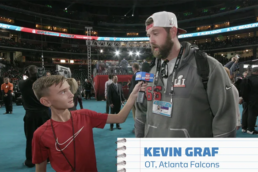
Sports Illustrated Kids interviews Patriots and Falcons at Super Bowl LI media day in Houston.
These initiatives serve both content and business. The result is much more efficient kids content, generating deeper engagement, and building revenue streams outside the traditional media universe.
Today is the streaming revolution, tomorrow maybe be something else, but innovation will always be the constant. Is the ability to transform the business and identify what plays the best. A thought from Viktor Frankl comes to my mind: “When we are no longer able to change a situation, we are challenged to change ourselves”.
Transforming Anxiety into Creative Energy
Fast-paced enviroment, calendars max-out with meetings, full inbox, and 4pm calls leave us with very little time for strategic activities. Even the best jobs and the best teams experience this pressure in one form or another. The harder you work and the more motivated you are to succeed, the easier we feel we have no time to accomplish what is important to us and also to the organization advance. A week goes too fast and too furious.
Time constraints can get the better of you, and this anxiety bleeds over into how we interact with people. We want to inspire our team, but we literally don’t have the time. How can we find the precious balance, be a good leader and still get things done? The answer maybe a bit hidden in between of meetings and dayly routine.
Small moments, big opportunities
Every day is a combination of smaller moments. So if we take those moments apart, into smaller, more manageable situations we can make more sense of our busy schedule. With this deconstruction process we can take any situation apart and then assemble it back together in new and unexpected ways (my partner specializes in fashion pattern deconstruction and was the inspiration for this idea). Elements on a situation may have been intermingled and the way you deal with one will impact on other parts of the problem.
How we use the small moments and brief interaction in our day? Small gestures and invisible situations can bring out the best leadership inspiration. We cannot fix everything, but we can make a difference. It makes me think of the small pebble creating big ripples in the water. I dont think even the pebble knows what is creating behind. Leading and inspiring is something you get better with practice and its done in step by step.
The first thing is to identify what these small moments in our everyday conversations and interactions at work, and even at home. We are too busy to take time but with little attention you’ll see them very clear as Neo sees the ‘Matrix’. You can seize a small moment into a learning opportunity.
Finding the ‘smaller parts’ can be a challenge, but once you identify this, everything becomes much easier and more productive.

Making space in our busy schedule is a challenge, but this terraforming creates an opportunity to growt and a vibrant playground for talent to make better products and services. Creativity is an energy and whether you realize it or not, you emit and receive energy. We have an electromagnetic field in which creative energy flows naturally, but when the polarity is disrupted our team creative energy system is affected. Is vital to pay attention, because is subtle but escalate quickly.
Become a power converter that change anxiety into creative energy
One of our focus, besides deadlines, meetings and product development is to motivate team members to grow, encourage intelligent dialogue, infuse confidence, and empowering the reach their best of their skills.Everything we do is fueled by it and foster creative energy is vital to the team and the work.
Find quick opportunities to grow a creative playground
-
Don’t try to solve the problem, listen first.
-
Create a space for dialogue and growth.
-
Give specific, constructive feedback.
-
Take time to know people.

Don’t try to solve the problem…first listen: When someone comes to you for help, we rush giving people suggestions when they ask for help. Ask them what they think would be a good solution and then create a space to implement it or try it out. By this, the team member can develop ownership of the solution, as they learn how to seize the opportunity and make a change.
Create space for dialogue and growth: People are afraid to admit a mistake because of the consequences, understandable. But when someone comes and says, “I think I made a mistake.” Don’t jump at it with all your artillery. Create an environment for growth and show them you trust them, even when there’s a mistake in the middle. We all make mistakes, remember. Think about the time you screwed-up and how you’d liked to be treated. This is a critical moment, especially in the process of innovation where failure is essential to the exploration process.
Give specific, constructive feedback: Concentrate on positive and specific suggestions on the situation and behavior. Not the person. Kindness and accuracy are important. Finally, what was the impact of the conflict or situation? Feedback is not criticism or praise, it is about observation. It’s timely and specific. It describes but doesn’t judge, and brings an understanding of the situation or issue. It’s one of the simplest yet most effective ways to develop others, creating a pattern of learning and growth.
Take time to know people: teams are made of people, personalities and attitudes. Recognize the diffences and look for ways to connect similar interest. A quick ”How are you, how’s everything? can open up a dialogue. Kindness is never out of fashion, and a bit of empathy can overcome frustrations and give you understanding on and how to offer support. It’s about build connections to inspire growth. Especially with creative teams, artists, designers, developers, well…everyone. Strive for authenticity, not perfection. Remember that conversation is with people, not to people.

Using VR in Hospital Treatments
Virtual Reality to Reduce Pain for Hospitalized Children
The VR technology enables pediatricians at children’s hospitals and healthcare facilities in the US to use the headsets as a procedural tool for critically ill young patients, primarily to reduce anxiety during mild to moderately painful procedures. By using VR as a calming distraction, several patients have been able to undergo these procedures whilst awake, cutting down lengthy recovery times, and reducing the need for medication. Lenovo Collaboration with Starlight Children’s Foundation® Shows how technology and hope can positively impact kids’ health to alleviate pain for young patients.
By using VR as a calming distraction, several patients have been able to undergo these procedures whilst awake, cutting down lengthy recovery times, and reducing the need for medication.
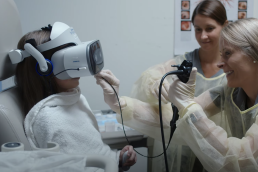
Improving the quality of life of hospitalized children
“Due to the distressing nature of treatments such as a lumbar puncture, where a needle is used to withdraw spinal fluid and sometimes administer medication, our patients often receive the procedure under general anesthetic. Virtual Reality can be used in place of general anesthesia to help tolerate pain, and in fact, it is having a profound impact on the quality of life of our hospitalized children. We are seeing children who used to require general anesthesia, now able to be fully awake with minimal medications.” Joe Albietz, MD, Medical Director at Child Life, Children’s Hospital Colorado
Digital Approach of Mental health during COVID-19
Since the pandemic started, social interactions have been limited, with authorities setting the maximum number of people in a group, in some cases imposing curfews. This all means that young individuals are subject to an increased risk of anxiety, social withdrawal, loneliness. Support groups and face-to-face services have been canceled, and many patients experienced relapses in mental conditions due to disruptions in school routines, which may serve as coping mechanisms. Children and adolescents have engaged with digital technologies so in many ways virtual reality therapy could be integrated to treat current mental health-related issues mentioned above.

Immersive VR to support mental health treatment
Virtual Reality therapy to treat anxiety, phobias, depression, stress, PTSD, and several mental health-related traumas. VR exposure therapy provides the opportunity for mental health professionals to not only reproduce real-life scenarios but also to adapt and control these environments to suit patients’ needs. This technology approach allows mental health professionals to evaluate, identify, and apply intervention protocols on patients’ fears and anxieties, in some cases showing quicker improvements, increasing the commitment to the therapy.
Watch the Stories
Programs that aim to integrate VR with traditional therapy techniques, improve the quality of hospitalized children and help with trauma.
A guide to raise entrepreneurial kids (Part 1)
To be at the top of the game, an entrepreneur requires creativity, empathy, communication skills, problem-solving ability, practical maths, and a knack for spotting something at the right moment and having the confidence to act. These key traits of entrepreneurs like presenting an idea, handle objections, or guide someone through tough decisions have their origin in the early stages of development and can be found at home or school in everyday activities. Let’s take a quick look:
1.Developing basic skills
To be at the top of the game, an entrepreneur requires creativity, empathy, communication skills, problem-solving ability, practical maths, and a knack for spotting opportunities at the right moment, and the confidence to act. These key traits of entrepreneurs have their origin in the early stages of a kid’s life and can be found at home or school in everyday activities. Although these kinds of skills -presenting ideas, handle objections, or guide someone through tough decisions- are often associated with entrepreneurs, are in fact the basic set of skills for kids that grow up ready to take on the world, ultimately steering them towards the right opportunity. Kids that develop the passion, the attitude, the skills to spot opportunities, resilience, faith, not afraid of critics and failures, are prepared to handle whatever life throws their way.
Starting at home: There are so many activities and fun things for kids to Inspire and nurture these skills. From negotiating what’s for dinner, or making decisions about planning the week, putting someone in charge of a task or a special event at home, like planning a Bday party.

2.Home-made skills
Raising kids with an awareness of entrepreneurship and its core skills can change their life for the better. Kids don’t need to actually be running a business, employing people, or pitching ideas to investors to gain these skills. Being a kid is already a serious business for them, so learning these skills should be fun and lighthearted. Kids are already practicing these skills at home at one point or another: pitching, negotiating, decision making, leadership, customer service, and creative thinking.
Practical examples: there are so many activities and fun things for kids to Inspire and nurture these skills. From negotiating what’s for dinner, or making decisions about planning the week, putting someone in charge of a task or a special event at home, like planning a Bday party. Challenges can be really fun and character-building.
Encouraging healthy debate about ways to help people or coming up with ideas to solve a problem so they can create their own framework for decision-making. Simple ideas that are fun, entrepreneurial and valuable. The earlier someone learns these skills the more second nature they will be in the future.

3. Opportunities are everywhere
Finding entrepreneurial opportunities involves playing and observing real-life situations. Allowing kids to experience and interact with real-life entrepreneurial scenarios will open their eyes to the possibilities. Not only in opportunities but also different people with different skills. Being open to opportunities means seeing the possibility and abundance of options and results, incorporating the notion that opportunities are everywhere, they just have to be found like a treasure hunt.
Great entrepreneurs look at problems and see solutions and disruption it’s only a chance to add value. They constantly think of new ideas for products, services and new businesses. Their brains become trained to seek out opportunities, working their idea muscles every day until eventually, success becomes real. Inspiring kids into an opportunity-seeing mindset involves thinking in that way yourself.
Foster questions that make kids think and observe their own paths and actions, opening playfully to the idea of “Why not” or “What if” Bring entrepreneurial opportunities closer by talking about their everyday activities and connect them to businesses or professions around them. Ask how they do, and how they do it, and which problems they encounter. Understanding the needs of the businesses all around you helps kids to become aware of possibilities, sparking ideas they could get involved in.
Practical example: observe situations around your home, neighborhood, or even current events that present a problem and need a solution, and bring up what could be done to solve the problem and “how could you be part of the solution, and what could you do about that?” Things like organizing the attic or organize a garage sale, or transforming a room into a ‘painting studio’ or maybe learning about things that might stir interest or relatable to kids like the technology behind video communications, healthcare professionals, or the different disciplines behind making videogames or a cartoon show. Kids will be fascinated.

Situations that need a solution at home or in the neighborhood and bring up what could be done to solve the problem and “how could you be part of the solution.
Wellness, the new luxury
Refreshing the concept of luxury
In China, a country renowned for its efficiency and high-performance workers, Gen Zers have embraced a more relaxed philosophy as a form of protest against a system they now feel is rigged for the rich and powerful. This ‘burnt out’ generation of discouraged millennials worldwide has been rebelling against unbalanced wages, intense work schedules, and a lack of job security, even before the pandemic, and after isolation and distress in result, people are looking to adjust their lifestyle to a more balanced, healthier experiences.
Many consumers have learned that comfort is more important than being fashionable. Wellness and self-care have suddenly become more of a priority than ever. Global brands should soon expect the traditional luxury fatigue. Although is a challenge, is not necessarily a bad thing, but is an opportunity to creatively refresh their portfolio and products offer, introduce new points of view that satisfy both needs. Wellness and aspirations.
Wellness and self-care have suddenly become more of a priority than ever and have the potential to revolutionize the luxury industry. Luxury brands can inspire this newfound awareness to create healthier and smarter lives.

Reducing the gap between traditional luxury through health and wellness
While consumers integrate wellness into every aspect of their daily lives, so there’s a new perfection that brands could change in their narrative. Outdated vertical luxury definitions fail to understand the convergence and multidimensional nature of wellness. Across sectors such as beauty, fashion, travel, and fitness, wellness is the world’s fastest-growing market segment. And affluent consumers are willing to pay a premium for perceived wellness solutions. Driven by Millennials, social media and online DTC retail, wellness brands can more easily grow globally.
Wellness has become a priority for most luxury consumers. A better understanding of the consequences of our lifestyle choices, and digital health trackers are contributing to inspiring modern affluent consumers to live healthier lives. Luxury brands need to integrate elements of wellness both in their offerings and marketing to capture increasingly health-conscious shoppers. An effective approach to wellness seizes opportunities to bolster a sustainable, healthy way of living whether through partnerships, cross-category expansions, and innovations, or new business models.
Affluent consumers demand natural and organic products. Fashion shoppers are drawn towards high-end athletic/leisure outfits both comfortable and stylish. Bars and restaurants are being replaced by gyms and fitness studios becoming new social hubs for affluent new generations.
The deep desire for health and wellness is radically reshaping what luxury brands need to offer to their consumers and how they communicate the value of their goods and services. Leading brands will be the ones whose efforts make positive contributions and empower consumers in their journey to wellbeing. Wellness is profoundly transforming the luxury industry. Brands creative, narrative and storytelling will benefit to incorporate elements of health and wellness that will resonate with the newfound awareness and new market.

Deepest renewal. La Mer’s iconic Miracle Broth™ reveals a bright, well-rested look.

Looking for a way to elevate your daily workouts or a way to turn heads at the gym? Louis Vuitton has just released the perfect accessory.
Inspire wellness through a new approach to luxury
On the domestic front, the retail industry has also experienced challenges since the onset of the pandemic. From margin pressure and shift to online shopping, affecting the footfall of domestic stores, malls, etc. Again, I believe all of this is a unique opportunity to create better digital experiences and cost-effective approaches, from creative to product development. The right digital initiative can help us measure effectiveness, traffic and better connect and engage with key stakeholders, inside company units, partners and audiences.
Through digital channels, with an aligned 360 vision across platforms, relevant narrative, brand commitment, proactive, small initiatives and MVPs that allow us to know better our audience and consumers, creating a customer experience that is engaging, personal, healthy, and valuable. Luxury brands are starting to catch up with the market trends into wellness awareness inspiring us to live healthier and smarter lives. A new luxury mindset, where the true luxury is reflected in wellness, comfort, and work-life balance. Accordingly, brands should be prepared for this new mindset that the YOLO economy has ushered in. In fact, today’s YOLO economy has the potential to revolutionize the luxury industry. COVID-19 was the catalyst, but this change was a long time coming.
Creating a better brand experience
DFTR is one of the cornerstones of growth and development for luxury brands. Travel corridors are the heartbeat of the experience, it’s a glamorous ‘elevators pitch’ a brief opportunity to connect, capture and engage with customers. The DFTR channel also functions as an export channel for consumers traveling between countries and regions across the globe. In a way like ‘brand ambassadors’ expanding the brand to their country of origin. All the changes in recent travel patterns create a unique opportunity for business & brand development.
I.Faster, Creative, Cost-Effective initiatives
Margin pressure, a shift in behaviors, footfall downfall in stores, etc. even challenging, foster a unique opportunity for better and small initiatives to connect and understand our consumers. We need smart, proactive, and cost-effective approaches, from creative marketing to product development. A 360 real-time vision across platforms, that knows and inspires audiences to create a better experience and lifestyle value, from packaging to an email marketing campaign, and connects with business partners, and even stakeholders in the team.
II.Connect creative strategy to your audience mindset.
Storytelling goes beyond language, screens, or platforms. It is something personal, a compelling mix of different experiences from both audience and brand content. We should inspire our audiences to create a healthier & balanced lifestyle. Technology has enabled new ways of extending and hosting the narrative and a different vision to understanding and implementing it. Technology enables a way to capitalize on consumer needs, share your commitment and focus to different audiences that otherwise would be impossible to reach. Segmentation is a tricky word, and without the proper reading can get you stuck, particularly in multifaceted markets. Many companies experience shortly lived growth because of this. A digital strategy is far more challenging than posting videos, regular updates, or pictures on social platforms. It’s an all-across brand collaboration to build a sensory experience and the proper narrative to drive the right story that understands the audience’s mindset.
III. Understand audiences beyond analytics.
Personalization and behavioral targeting will give you the conversion, but we also look for engagement and connection with our audience. I’m not talking about just creating an ad in a language like Spanish or Chinese. I’m referring to content that appeals and is relevant to customers where they are. Knowing the market goes beyond analytics and statistics, Is understanding that content is a way to expand your brand universe to reach new and existing audiences with innovation and creativity, a fresh perspective on the delivery/platform, connecting with customers where they anytime, anywhere. No matter is an airport or the gym.
APAC corridors are the leading driver on the luxury market travel retail. That’s why understanding the traveling consumer and adjusting POS creative strategies to better connect with clients in a more personal way using technology and partnership with retails, airlines, etc. I experience this while working with United Airlines digital creative programs for the Asia Pacific.
IV. Align Digital & In-Store experiences.
The balance between store experience and digital experience is challenging. Creating cross channels experience is not just an app or an online campaign. Brands need to stay cost-effective in any of the verticals, but beyond that, is also how the market is moving on. The combination of digital & sensory experience is vital. While working in Quadramma I created several digital experiences with this in mind. Buyer patterns are constantly changing but your message should remain constant at every touchpoint.
We partner with Starbucks to create their first mobile experience in LatAm that was really a huge hit: customers could share a personalized holiday message to friends and acquaintances decorating their favorite seasonal drinks. Or Jazmin Chebar with an in-store app with exclusive content. Once customers were in the stores, they took pictures, share content, watch live streams, and use in-store iPads. Beyond the product, we wanted to connect with what the audience thinks, does, and wants.




